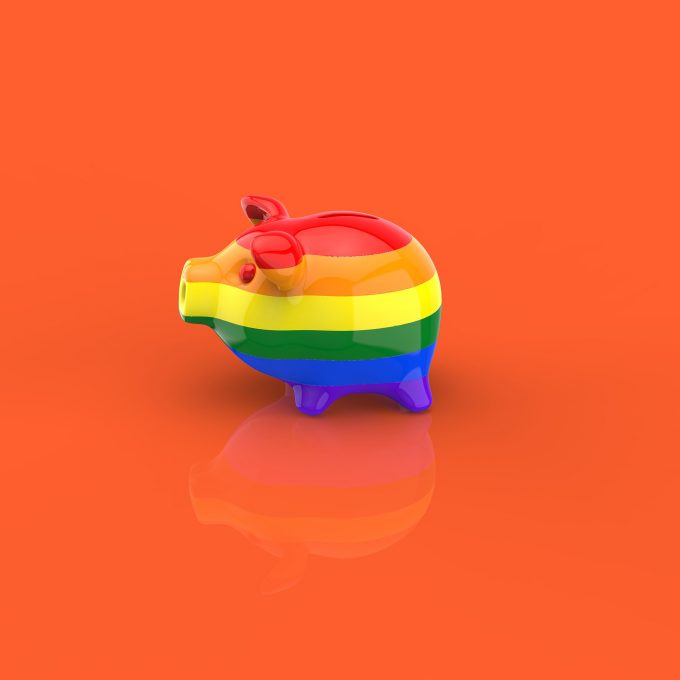Socioeconomic Patterns Among Sexual Minorities

“There is wide socioeconomic variation among LGB people that has been overlooked by previous research even though socioeconomic status is deeply intertwined with sexual minority status and union status.”
Sexual orientation became a major site of political conflict and social change in the 20th Century, continuing into the 21st century. Research, activism, and policy decisions altered the visibility of lesbian, gay, bisexual (LGB) and other sexual minority identities in the U.S., particularly after the U.S. Supreme Court, in Obergefell v. Hodges, ruled all bans on same-sex marriage illegal in 2015.
Alongside continued struggles for legal equality, population-based surveys—from which we are able to understand the socio-demographic profi le of groups of people—have not accurately measured socioeconomic status (SES). SES represents the combination of one’s social prestige, wealth, and power—the rapid changes in the social status of LGB people has left considerable confusion about their SES. The confusion over sexual minority SES arose in part because until 2013, national surveys such as NHIS, BRFSS, or the Census Bureau data did not ask for sexual identity. Instead, researchers who used these surveys proxied sexual identity by identifying same-sex couples.
This was a new step forward in research on same-sex couples, but created major issues for a holistic understanding of sexual minority SES. Only people who were in same-sex cohabiting or married couples at the time of the survey “counted” as sexual minorities, missing a large number of LGB people. For example, sexual minorities who were single when interviewed were obviously not counted, but neither were LGB people in different-sex relationships. As such, an understanding SES differences between bisexual people and lesbian and gay people were entirely lost. We show exactly what was missed by this approach and what we have to gain with better data, using up-to-date statistics on sexual minorities’ relationship status from IPUMS NHIS data from 2013 to 2018.
One of the first population-based national datasets that ask people their sexual orientation is the National Health Interview Surveys (NHIS). The IPUMS-NHIS is a publicly available version of that survey that provides a nationally representative snapshot of the U.S. population each year. IPUMS-NHIS provides several sexual orientation identity categories, but we focus on people identified as “Lesbian or gay,” “Bisexual,” and “Straight, that is, not lesbian or gay” because they are the most well-defined and numerous categories. We examined only adults aged 18-65 because retirement affects SES in ways that would have muddied our interpretation. The data from 2013 to 2018 included 139,721 people. We examined two aspects of SES among sexual orientation groups: poverty status and educational attainment.
Figure 1 shows how much we miss by identifying sexual minorities based only on relationship status. For example, we missed 59 percent of the lesbian/ gay population by focusing on couple relationships: 53.3 percent of lesbian/gay respondents were single, and another 6 percent were in different-sex couples. We also missed almost all bisexuals since 31.6 percent of bisexuals were in different-sex couples and 63.8 percent were single.

It turns out that this is not only a massive loss of data; it is, more importantly, a crucial lack of visibility for bisexual people, who face higher rates of poverty and lower educational attainment than lesbian/gay people overall. Figure 2 shows SES variables separately for sexual orientation. One in four bisexual people lived below the poverty line compared to only about one in eight straight and lesbian/gay people. Using only people in relationships would have resulted in estimates of LGB people in poverty to have been only 6.2 percent instead.
Figure 3 demonstrates why focusing only on relationship status obscures the variation in SES among LGB people. The first point is the omission of single people from couple-level data. Single people, regardless of sexual orientation, have higher poverty rates than partnered people of the same sexual orientation. As shown in Figure 1, LGB people were more likely to be single than straight people, and bisexual people were more likely to be single than lesbian or gay people. Not only did we disproportionately under-count and overlook LGB people when we used couples to identify sexual minorities, we also overlooked the sexual minorities who were most vulnerable socioeconomically according to relationship status.
The second point is the extent of the disadvantages faced by bisexual people. When using couples to identify sexual minorities, we could not separate lesbian, gay, and bisexual identities. That means we missed bisexual people’s disadvantages relative to straight and lesbian/gay people. For example, single bisexuals were roughly 1.5 times more likely to be in poverty than single lesbian/gay or straight people, different-sex cohabiting bisexuals were even more likely to be in poverty than the other different-sex cohabitors. A similar pattern emerged among cohabiting and different-sex married bisexuals, who had higher poverty rates than their straight or lesbian/gay counterparts.



Patterns of educational attainment also highlight diversity among sexual minorities. Perhaps most interestingly, a lower proportion of different-sex partnered sexual minorities had a bachelor’s degree or higher educational attainment than same-sex partnered sexual minorities. For example, 71.0 percent of same-sex married bisexuals had bachelor’s degrees or higher compared to 38.8 percent of different-sex married bisexuals. Similarly, 47.9 percent of same-sex cohabiting lesbian and gay people had bachelor’s degrees or higher compared to 25.8 percent of different-sex cohabiting lesbian and gay people.
The disparity may mean that people who identify as sexual minorities and have attained higher education find it easier to meet same-sex partners. That may happen if, for example, people with higher educational attainment organized LGBTQ+ community and social events that catered to other middle- and upper-middle-class people. The disparity also may reflect how higher education opens up pathways to more accepting communities.
Bisexuals’ disadvantages were not as pronounced for education as they were for poverty, which suggests that something other than educational inequality drives bisexuals’ socioeconomic disadvantages. Due to harmful stereotypes and discrimination, bisexual people often feel excluded from both straight and lesbian/ gay social contexts, which may contribute to fewer opportunities to translate their education into income. Still, 10 percent more single lesbian and gay people had a bachelor’s degree or higher than bisexual people, highlighting important educational attainment disparities.
Past measurement of socioeconomic status by comparing same- and different-sex households based on relationship status mislead the public and researchers while obscuring important vulnerabilities. Identifying only people in same-sex couples conflates the effects of being in a same-sex couple with being a sexual minority. Relying on same-sex couples would lead us to estimate LGB poverty at half of its actual value. In doing so, we overlook the disproportionate economic disadvantages faced by bisexuals and single LGB people.
This is more than a methodological quibble. As noted earlier, statistics about economic risks are often used to set policy. By overlooking lower-SES and single LGB people in research, we may inadvertently shape policy contexts that disadvantage underserved and underrepresented populations. As research moves forward, we should look at the intersections of social inequalities and their impact on people’s life outcomes. By attending to both shared experiences (e.g., sexual orientation, relationship status, and SES) as well as the important differences within groups, we can craft more accurate research and policy that work toward a more equitable world.


Recommended Reading
Badgett, M. V. Lee . 2018. “Left Out? Lesbian, Gay, and Bisexual Poverty in the U.S.” Population Research and Policy Review 37: 667–702.
Google Scholar | Crossref
Black, Dan A., Sanders, Seth G., Taylor, Lowell J. 2007. “The Economics of Lesbian and Gay Families.” Journal of Economic Perspectives 21:54–70.
Google Scholar | Crossref
Hui, Liu, Reczek, Rin, Brown, Dustin. 2013. “Same-sex Cohabitors and Health: The Role of Race-ethnicity, Gender, and Socioeconomic Status.” Journal of Health and Social Behavior 54: 25–45.
Google Scholar
McGarrity, Larissa A. 2014. “Socioeconomic Status as a Context for Minority Stress and Health Disparities among Lesbian, Gay, and Bisexual Individuals.” Psychology of Sexual Orientation and Gender Diversity 1: 383–397.
Google Scholar | Crossref
Spiker, Russell, Stacey, Lawrence, Reczek, Rin. 2021. “Sexual and Gender Minority Health: Toward a More Complete Accounting of Social Class.” Pp. 17–37 in Advances in Medical Sociology, Vol 21: Sexual and Gender Minority Health. Eds. LeBlanc, Allen J., Perry, Brea. Bingley, UK: Emerald Publishing.
Google Scholar | Crossref
